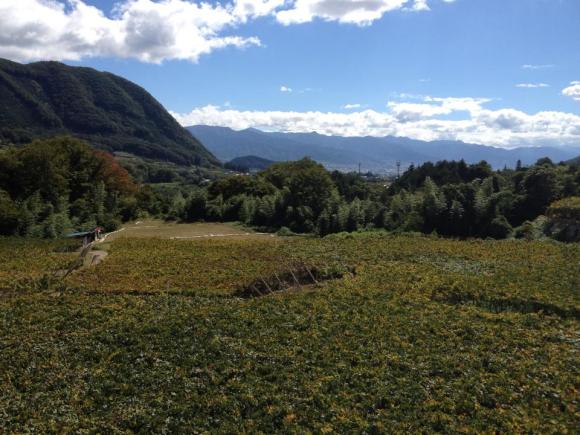
When you think booze and Japan, wine is probably the last thing that comes to mind, and not without good reason. This is a country where the average wine list can be summed up as “red or white?”, both of which will come probably from an ancient box in the back of the fridge and chilled to near-zero temps.
The country is not without its fans of wine culture, though. In fact, Japan even has a wine-producing region, home to 31 wineries and an original grape variety! Katsunuma, sometimes called the Napa Valley of Japan, is tucked into the mountains of Yamanashi Prefecture, just an hour and a half from Tokyo.
RocketNews24 went to check out this grapey paradise on the occasion of the Katsunuma Wine and Grape Festival, where rumor had it 500 yen would get you unlimited wine for the day.
When we arrived at the festival area, the first thing we noticed is that the festival grounds were split into a wine section and a grape section, with a line of food stalls along one side and a stage on the other. Now guess which part was most popular.
▼ Literally, “wine village”. Home sweet home.
▼ And “grape village”. The long line is people waiting to get a free bunch of grapes, something that happened several times throughout the day.
The first step for most people is buying a souvenir glass. For 500 yen (US$5), you get the glass, a handful of breadsticks, and, more importantly, access to free wine–and grape juice, but come on!–all day. Not only can you help yourself to full glasses of red or white wine at the wine tent, but you can visit the booths of 24 participating wineries to do tastings. With each winery offering at least 3 or 4 tasting wines, you could drink all day and barely make a dent.
▼ Glass in hand, ready to rumble.
We decided to try a glass of Koshu wine first. Koshu grapes have been grown as table grapes in Japan for about a thousand years, having come from the Caucuses over the Silk Road. In the late 1800s, two French-trained vintners here started using it to make a very dry, citrusy white wine.
▼ Bottles of Koshu wine being poured into casks for self-service. Why? Because, that’s why.
Wine in hand, we decided to check out our options for food. Best not to drink on an empty stomach, right? In addition to the usual festival foods, there were local specialties on offer. Katsunuma produces a lot of grapes, but also a lot of chickens, apparently.
▼ Sauteed chicken skin. Tastes about how you would expect: greasy and rubbery.
▼ Katsunuma yakisoba, with thick noodles and locally sourced minced chicken. Very tasty!
Our bellies full of noodles and chicken, we headed back to the wine tasting area. If you are interested in the Koshu variety, this is a really great opportunity to see what can be done with it because almost every winery offers one. They range from the very acidic to something a bit more mineral, depending on what the wine is aged in. Some wineries are even using it to make sparkling wine.
Koshu isn’t the only varietal in town, though. We saw quite a lot of Muscat Bailey-A, a domestic grape hailing from Niigata that makes sweetish red wines. There were some straight Chardonnays, Pinot Noirs and Cabernet Sauvignons, but blends were probably the most common. I was actually surprised by the number of varietals being grown in the area, but that may be because there is still a great deal of experimentation going on in this relatively young industry. Correspondingly, the quality of the wines is a bit hit or miss, even within individual wineries.
▼Bottles on display at one of the most amusingly named wineries: Huggy.
Things were starting to get a bit blurry by this point, so we decided to head over to the grape section and see what was going on. Surprisingly, we had at least as much fun on this side as on the wine side.
▼A grape skin spitting contest. This here is the world champ. You can see the determination on his face.
▼VICTORY!
▼An impressive almost 8 meters.
▼Grape speed-eating contest, with a bottle of wine going to the winner in each heat.
▼Apparently, it still counts when you just have everything chipmunked away in your cheeks. Even the MC is shocked.
▼What would a Japanese festival be without a mascot? Strangely, a peach…
▼And pretty ladies handing out free samples?
The finale of the festival is a fireworks show and bonfire at dusk, but by this time, the number of people passed out around the festival grounds was quite impressive. Most people brought tarps or tents to lie on, but pretty much any surface will do after a certain amount of wine.
This is also about the time that many of the wineries started running out and the free wine tent started closing up. But after about seven hours of uninterrupted drinking, no one seemed to mind. People snoozed or danced around with the mikoshi procession, but it felt mostly like they were killing time until the fireworks show.
Finally, the sun went down and the taiko drums came out. As they play, a bonfire is lit, sending a signal to people on a nearby mountain to light up the torii gate. Once it finally gets going, the fireworks start, and there are actually two competing shows; one over the festival grounds and one from the nearby Budou no Oka complex.
As we dragged our wine-soaked bodies back to our hotel, I was equally sure of two things: I was going to have a killer hangover the next day and I was definitely going to be back next year.
Source: RocketNews24
Images: RocketNews24, Yamanashi Kankou